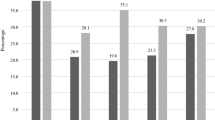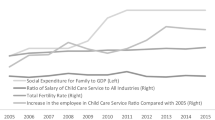Abstract
The central concept of microeconomic theories of fertility is opportunity cost—the product of wife’s employment lost due to childbearing and the value of her employment. This paper presents a model for analyzing opportunity cost using panel data. The average loss of employment attributable to a second- or higher-order birth, calculated at around age 2, is over 400 hours per year. This time cost represents an income loss of about $1050 in 1969 dollars. Time cost is independent of such demographic factors as birth order and age of oldest sibling. Neither does time cost depend on husband’s wage rate or wife’s education or potential wage rate. This indicates that many microeconomic models of fertility have been seriously misspecified. The paper also compares results from static and dynamic models, explores possible problems due to simultaneity bias, investigates the relationship between changes in employment (including time cost) and initial employment level, and identifies the difficulties of theorizing about opportunity cost.
Similar content being viewed by others
References
Bahr, S. J. 1974. Effects on Power and Division of Labor in the Family. Pp.167–185 in Lois W. Hoffman and F. I. Nye (eds.), Working Mothers. San Francisco: Jossey-Bass.
Becker, Gary S. 1975. Human Capital. (Second edition.) New York: National Bureau of Economic Research.
Berelson, B. 1976. Social Science Research on Population: A Review. Population and Development Review 2:219–266.
Bowen, William G., and T. Aldrich Finegan. 1969. The Economics of Labor Force Participation. Princeton: Princeton University Press.
Cain, G. 1971. Issues in the Economics of a Population Policy for the United States. American Economic Review 61:408–417.
—, and A. Weininger. 1973. Economic Determinants of Fertility: Results from Cross-Sectional Aggregate Data. Demography 10:205–223.
Coleman, James S. 1968. The Mathematical Study of Change. Pp.428–478 in Hubert M. Blalock and Anne Blalock (eds.), Methodology in Social Research. New York: McGraw-Hill.
De Tray, D. N. 1973. Child Quality and the Demand for Children. Journal of Political Economy 81:S70-S95.
Dickinson, Jonathan. 1974a. Labor Supply of Family Members. Pp.177–250 in James N. Morgan (ed.), Five Thousand American Families: Patterns of Economic Progress, Vol. 1. Ann Arbor: Institute for Social Research.
— 1974b. Categorical Interactions in Linear Regression Models. Pp.365–374 in James N. Morgan (ed.), Five Thousand American Families: Patterns of Economic Progress, Vol. 1.Ann Arbor: Institute for Social Research.
Dixon, Ruth B. 1975. Women’s Rights and Fertility. Reports on Population/Family Planning No. 17. New York: The Population Council.
Easterlin, R. A. 1969. Towards a Socioeconomic Theory of Fertility: A Survey of Recent Research on Economic Factors in American Fertility. Pp. 127–156 in S. J. Behrman, Leslie Corsa, and Ronald Freedman (eds.), Fertility and Family Planning: A World View. Ann Arbor: University of Michigan Press.
Ghez, Gilbert R., and G. S. Becker. 1975. The Allocation of Time and Goods Over the Life Cycle. New York: Columbia University Press for the National Bureau of Economic Research.
Harris, Chester W. 1963. Problems in Measuring Change. Madison: University of Wisconsin Press.
Hawthorn, Geoffrey. 1970. The Sociology of Fertility. London: Collier-Macmillan.
Hibbs, D. A., Jr. 1974. Problems of Statistical Estimation and Causal Inference in Time Series Regression Models. Pp,252–308 in Herbert L. Costner (ed.), Sociological Methodology 1973–74. San Francisco: Jossey-Bass.
Hill, C. R., and F. P. Stafford. 1974. Allocation of Time to Pre-school Children and Educational Opportunity. Journal of Human Resources 9:323–341.
Hout, M. 1977. A Cautionary Note on the Use of Two-Stage Least Squares. Sociological Methods and Research 5:335–345.
Lansing, John B., and James N. Morgan. 1971. Economic Survey Methods. Ann Arbor: Institute for Social Research.
Leibenstein, H. 1974. An Interpretation of the Economic Theory of Fertility: Promising Path or Blind Alley? Journal of Economic Literature 12:457–479.
Michael, R. T. 1973. Education and the Derived Demand for Children. Journal of Political Economy 81:S128-S164.
Morgan, James N., Katherine Dickinson, Jonathan Dickinson, Jacob Benus, and Greg Duncan. 1974. Five Thousand American Families: Patterns of Economic Progress, Vols. 1 and 2. Ann Arbor: Institute for Social Research.
Namboodiri, N. K. 1972. Some Observations on the Economic Framework for Fertility Analysis. Population Studies 26:185–206.
—. 1974. Which Couples at Given Parities Expect to Have Additional Births? An Exercise in Discriminant Analysis. Demography 11:45–56.
Nerlove, M. 1974. Household and Economy: Toward a New Theory of Population and Economic Growth. Journal of Political Economy 82:S200-S218.
Oppenheimer, Valerie Kincade. 1970. The Female Labor Force in the United States. Berkeley: Institute of International Studies.
Rao, Potluri, and Roger L. Miller. 1971. Applied Econometrics. Belmont, California: Wadsworth.
Ryder, Norman B., and Charles F. Westoff. 1971. Reproduction in the United States, 1965. Princeton: Princeton University Press.
Scanzoni, John. 1972. Sexual Bargaining: Power Politics in the American Marriage. Englewood Cliffs: Prentice-Hall.
Schultz, T. P. 1973. A Preliminary Survey of Economic Analyses of Fertility. American Economic Review 63:71–78.
Simon, H. A. 1966. Theories of Decision-Making in Economics and Behavioral Science. Pp.1–28 in American Economic Association and Royal Economic Society, Surveys of Economic Theory, Vol. III: Resource Allocation. New York: St. Martin’s.
Sweet, J. A. 1972. Labor Force Reentry by Mothers of Young Children. Social Science Research 1:189–210.
—. 1973. Women in the Labor Force. New York: Seminar.
Turchi, Boone A. 1975a. The Demand for Children: The Economics of Fertility in the United States. Cambridge: Ballinger.
—. 1975b. Microeconomic Theories of Fertility: A Critique. Social Forces 54:107–125.
Willis, R. J. 1973. A New Approach to the Economic Theory of Fertility Behavior. Journal of Political Economy 81:S14-S64.
Author information
Authors and Affiliations
Rights and permissions
About this article
Cite this article
Cramer, J.C. Employment trends ofyoung mothers and the opportunity cost of babies in the United States. Demography 16, 177–197 (1979). https://doi.org/10.2307/2061137
Issue Date:
DOI: https://doi.org/10.2307/2061137




